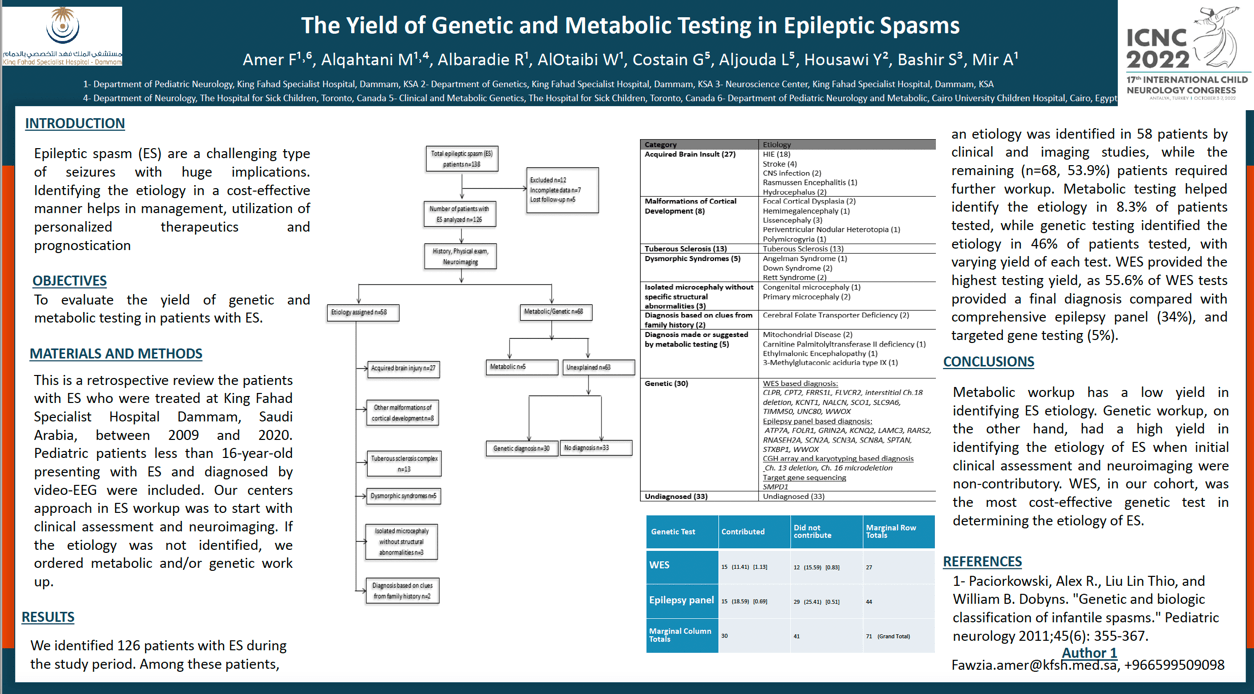The Yield of Genetic and Metabolic Testing in Epileptic Spasms
Mohammed Azib M AlQahtani, Raidah Albaradie, Yousef Housawi, Fawzia Amer, Wajd AlOtaibi, Gregory Costain, Liali Aljouda, Shahid Bashir, Ali Mir
Objectives: To evaluate the yield of genetic and metabolic testing in patients with epileptic spasms (ES).
Background: ES are a challenging type of seizures with huge implications. Identifying the etiology in a cost-effective manner helps in management, utilization of personalized therapeutics and prognostication.
Methods: Retrospective review of the medical records of patients with ES who were treated at King Fahad Specialist Hospital, in Saudi Arabia, between 2009 and 2020. Pediatric patients less than 16-year-old presenting with ES and diagnosed by video-EEG were included.
Our centers approach in ES workup was to start with clinical assessment and neuroimaging. If the etiology was not identified, we ordered metabolic and/or genetic work up.
Results: We identified (n=121) patients with ES during the study period. Among these patients, an etiology was identified in 58 patients by clinical and imaging studies, while the remaining (n=63, 52%) patients required further workup. Metabolic testing helped identify the etiology in 5.3% of patients tested, while genetic testing identified the etiology in 41.2% of patients tested, with varying yield of each test. WES provided the highest testing yield, as 52% of WES tests provided a final diagnosis compared with comprehensive genetic panel (28.1%), and targeted gene testing (10%).
Conclusions: Metabolic workup has a low yield in identifying ES etiology. Genetic workup, on the other hand, had a high yield in identifying the etiology of ES when initial clinical assessment and neuroimaging were non-contributory. WES, in our cohort, was the most cost-effective genetic test in determining the etiology of ES.
Keywords: Epileptic spasms, infantile spasms, genetic testing
Mohammed Azib M AlQahtani
the Hospital for Sick Children
Canada
Raidah Albaradie
King Fahad Specialist Hospital in Dammam
Saudi Arabia
Yousef Housawi
King Fahad Specialist Hospital in Dammam
Saudi Arabia
Fawzia Amer
King Fahad Specialist Hospital in Dammam
Saudi Arabia
Wajd AlOtaibi
King Fahad Specialist Hospital in Dammam
Saudi Arabia
Gregory Costain
the Hospital for Sick Children
Canada
Liali Aljouda
The Hospital for Sick Children
Canada
Shahid Bashir
King Fahad Specialist Hospital in Dammam
Saudi Arabia
Ali Mir
King Fahad Specialist Hospital in Dammam
Saudi Arabia
Objectives: To evaluate the yield of genetic and metabolic testing in patients with epileptic spasms (ES).
Background: ES are a challenging type of seizures with huge implications. Identifying the etiology in a cost-effective manner helps in management, utilization of personalized therapeutics and prognostication.
Methods: Retrospective review of the medical records of patients with ES who were treated at King Fahad Specialist Hospital, in Saudi Arabia, between 2009 and 2020. Pediatric patients less than 16-year-old presenting with ES and diagnosed by video-EEG were included.
Our centers approach in ES workup was to start with clinical assessment and neuroimaging. If the etiology was not identified, we ordered metabolic and/or genetic work up.
Results: We identified (n=121) patients with ES during the study period. Among these patients, an etiology was identified in 58 patients by clinical and imaging studies, while the remaining (n=63, 52%) patients required further workup. Metabolic testing helped identify the etiology in 5.3% of patients tested, while genetic testing identified the etiology in 41.2% of patients tested, with varying yield of each test. WES provided the highest testing yield, as 52% of WES tests provided a final diagnosis compared with comprehensive genetic panel (28.1%), and targeted gene testing (10%).
Conclusions: Metabolic workup has a low yield in identifying ES etiology. Genetic workup, on the other hand, had a high yield in identifying the etiology of ES when initial clinical assessment and neuroimaging were non-contributory. WES, in our cohort, was the most cost-effective genetic test in determining the etiology of ES.
Keywords: Epileptic spasms, infantile spasms, genetic testing
Mohammed Azib M AlQahtani
the Hospital for Sick Children
Canada
Raidah Albaradie
King Fahad Specialist Hospital in Dammam
Saudi Arabia
Yousef Housawi
King Fahad Specialist Hospital in Dammam
Saudi Arabia
Fawzia Amer
King Fahad Specialist Hospital in Dammam
Saudi Arabia
Wajd AlOtaibi
King Fahad Specialist Hospital in Dammam
Saudi Arabia
Gregory Costain
the Hospital for Sick Children
Canada
Liali Aljouda
The Hospital for Sick Children
Canada
Shahid Bashir
King Fahad Specialist Hospital in Dammam
Saudi Arabia
Ali Mir
King Fahad Specialist Hospital in Dammam
Saudi Arabia
